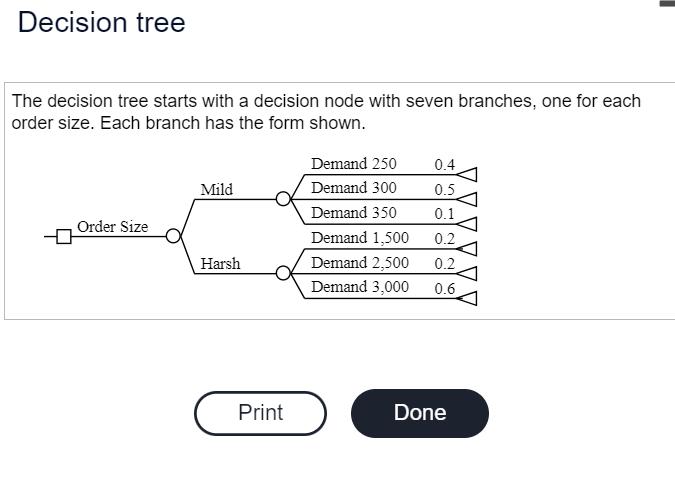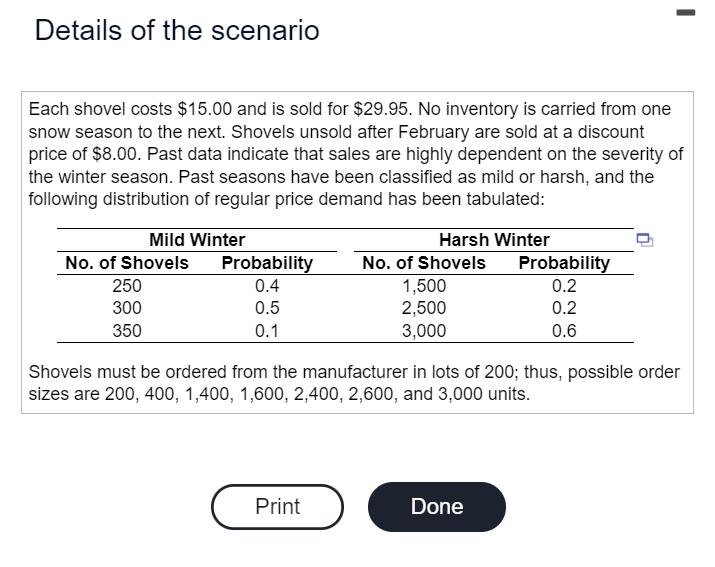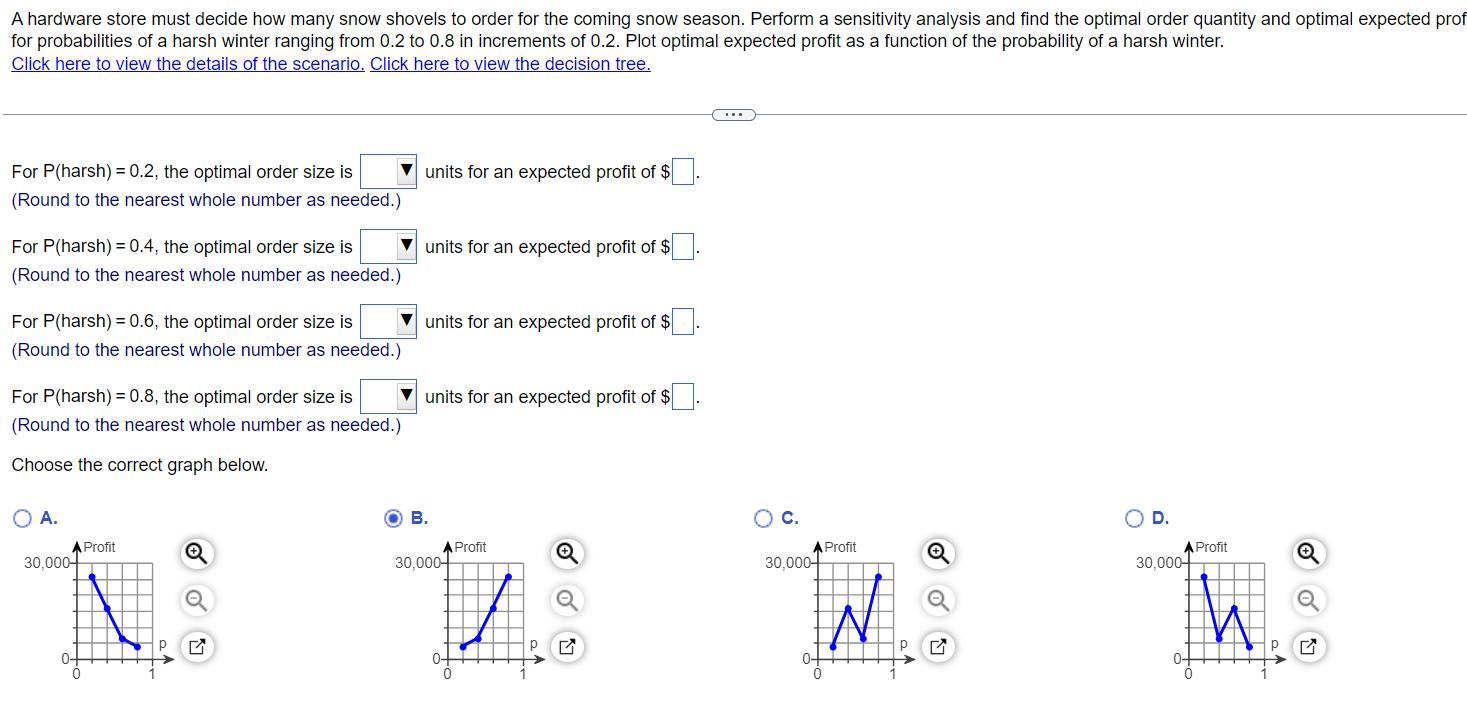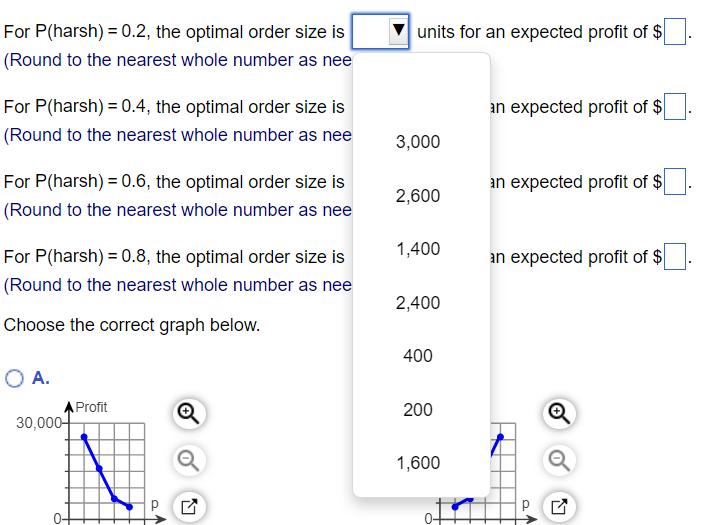Answered step by step
Verified Expert Solution
Question
1 Approved Answer
Decision tree The decision tree starts with a decision node with seven branches, one for each order size. Each branch has the form shown.




Decision tree The decision tree starts with a decision node with seven branches, one for each order size. Each branch has the form shown. Order Size Mild Harsh Print Demand 250 0.4 Demand 300 0.5 Demand 350 0.1 Demand 1,500 0.2 Demand 2,500 0.2 Demand 3,000 0.6 Done Details of the scenario Each shovel costs $15.00 and is sold for $29.95. No inventory is carried from one snow season to the next. Shovels unsold after February are sold at a discount price of $8.00. Past data indicate that sales are highly dependent on the severity of the winter season. Past seasons have been classified as mild or harsh, and the following distribution of regular price demand has been tabulated: Mild Winter No. of Shovels 250 300 350 Probability 0.4 0.5 0.1 Harsh Winter Print No. of Shovels 1,500 2,500 3,000 Shovels must be ordered from the manufacturer in lots of 200; thus, possible order sizes are 200, 400, 1,400, 1,600, 2,400, 2,600, and 3,000 units. Probability 0.2 0.2 0.6 Done A hardware store must decide how many snow shovels to order for the coming snow season. Perform a sensitivity analysis and find the optimal order quantity and optimal expected prof for probabilities of a harsh winter ranging from 0.2 to 0.8 in increments of 0.2. Plot optimal expected profit as a function of the probability of a harsh winter. Click here to view the details of the scenario. Click here to view the decision tree. For P(harsh) = 0.2, the optimal order size is (Round to the nearest whole number as needed.) For P(harsh) = 0.4, the optimal order size is (Round to the nearest whole number as needed.) For P(harsh) = 0.6, the optimal order size is (Round to the nearest whole number as needed.) For P(harsh) = 0.8, the optimal order size is (Round to the nearest whole number as needed.) Choose the correct graph below. O A. Profit 30,000+ 0- 0 P Q units for an expected profit of $ units for an expected profit of $ units for an expected profit of $ units for an expected profit of $ B. 30,000 A Profit 0 P **** O C. 30,000 0- Profit N P Q O D. Profit 30,000 0- 0 P Q For P(harsh) = 0.2, the optimal order size is (Round to the nearest whole number as nee For P(harsh) = 0.4, the optimal order size is (Round to the nearest whole number as nee For P(harsh) = 0.6, the optimal order size is (Round to the nearest whole number as nee For P(harsh) = 0.8, the optimal order size is (Round to the nearest whole number as nee Choose the correct graph below. O A. Profit 30,000+ P Q units for an expected profit of $ 3,000 2,600 1,400 2,400 400 200 1,600 0+ an expected profit of $ an expected profit of $ an expected profit of $ P Q
Step by Step Solution
There are 3 Steps involved in it
Step: 1

Get Instant Access to Expert-Tailored Solutions
See step-by-step solutions with expert insights and AI powered tools for academic success
Step: 2

Step: 3

Ace Your Homework with AI
Get the answers you need in no time with our AI-driven, step-by-step assistance
Get Started


